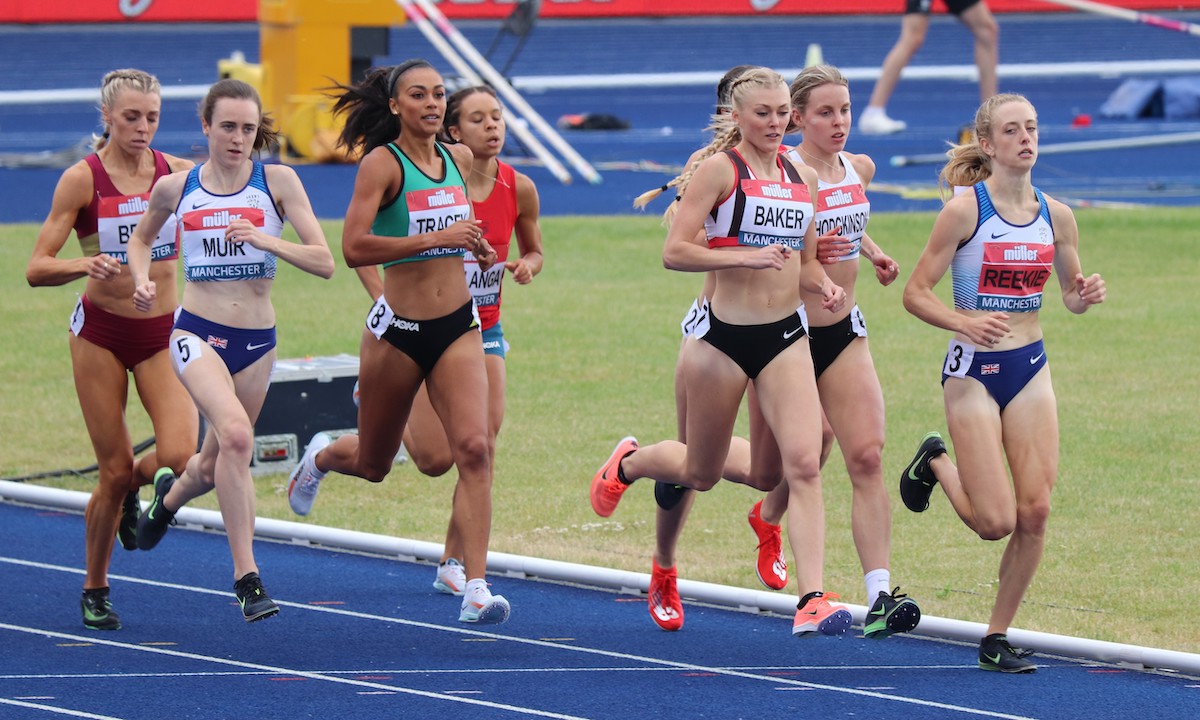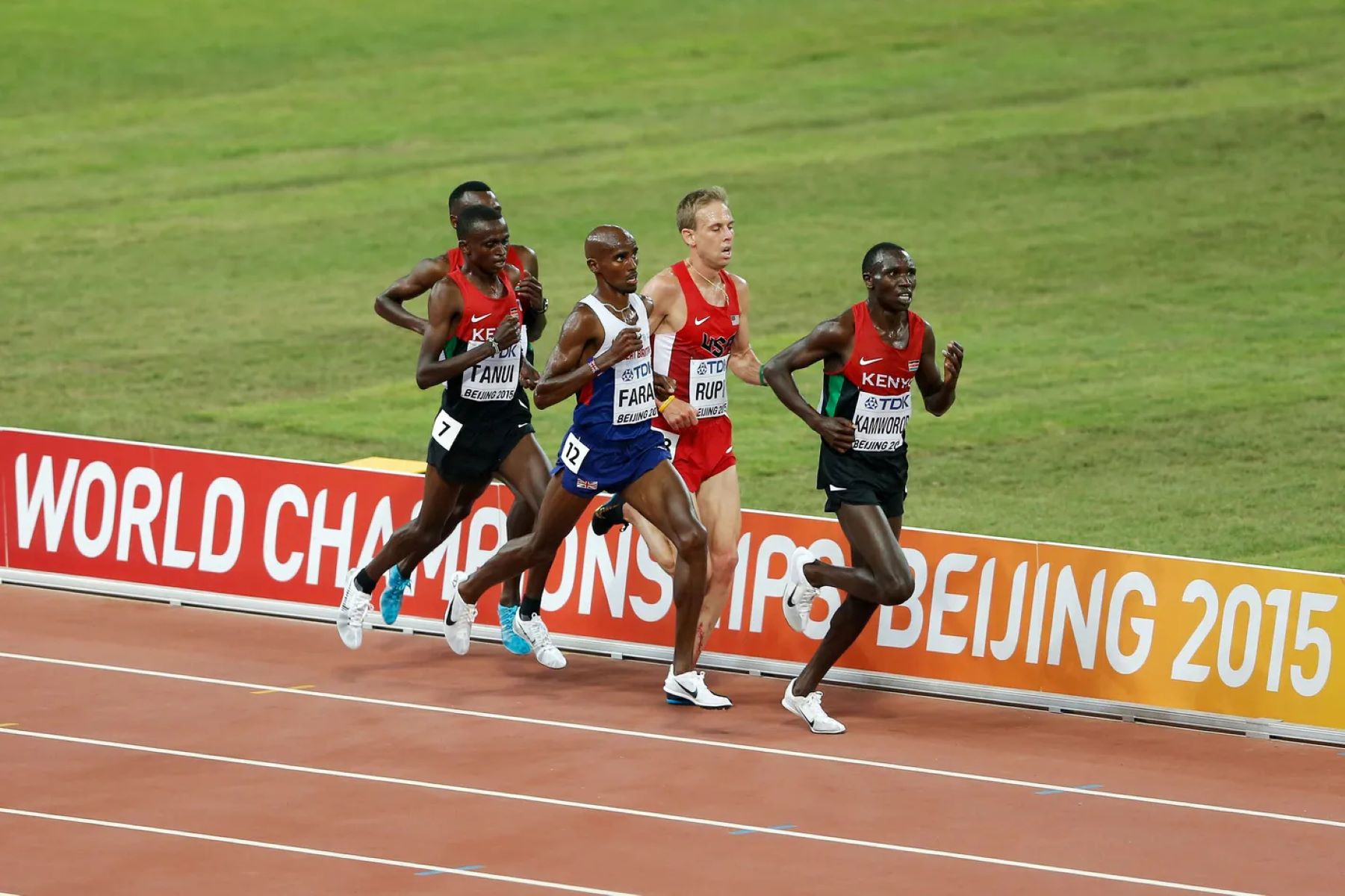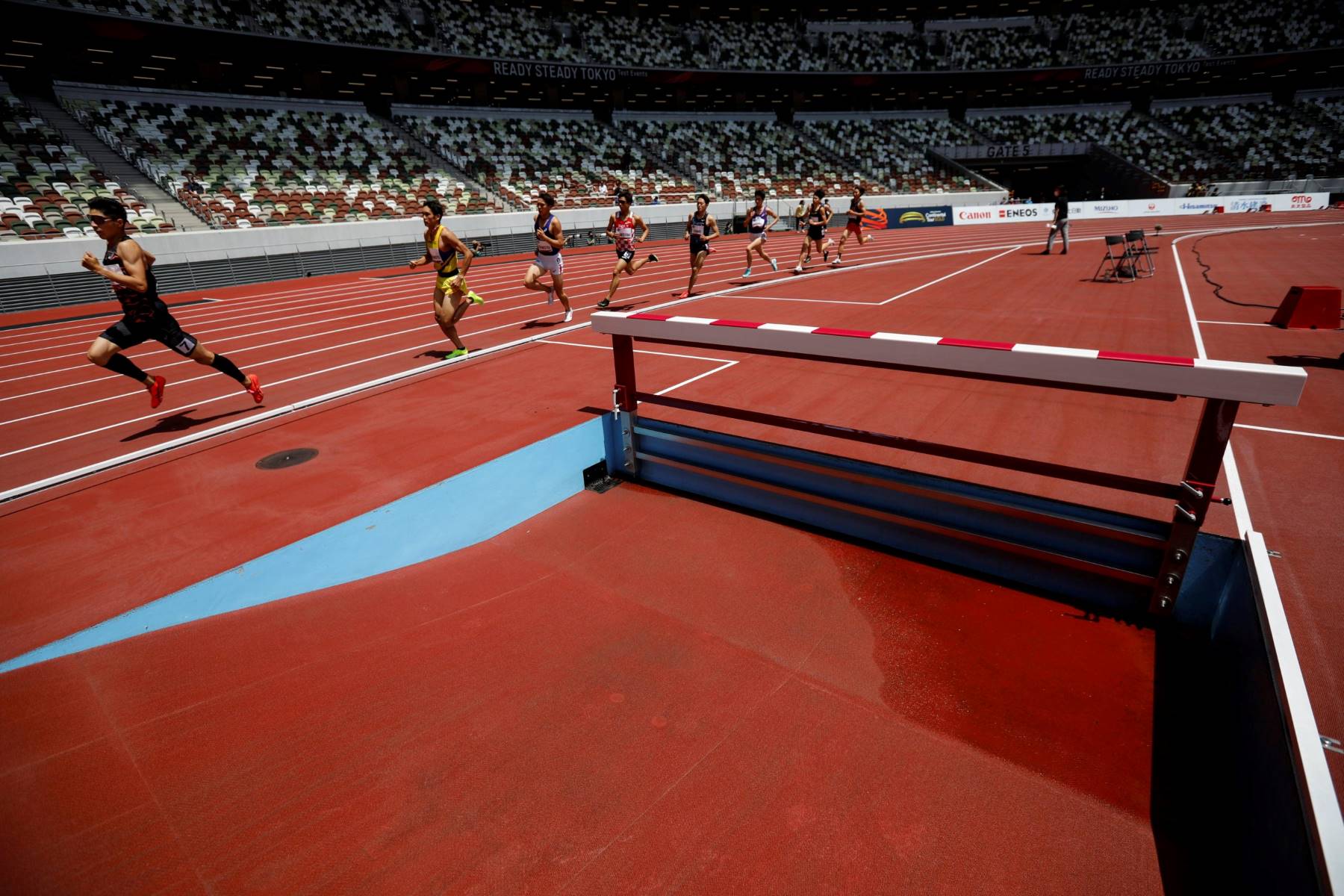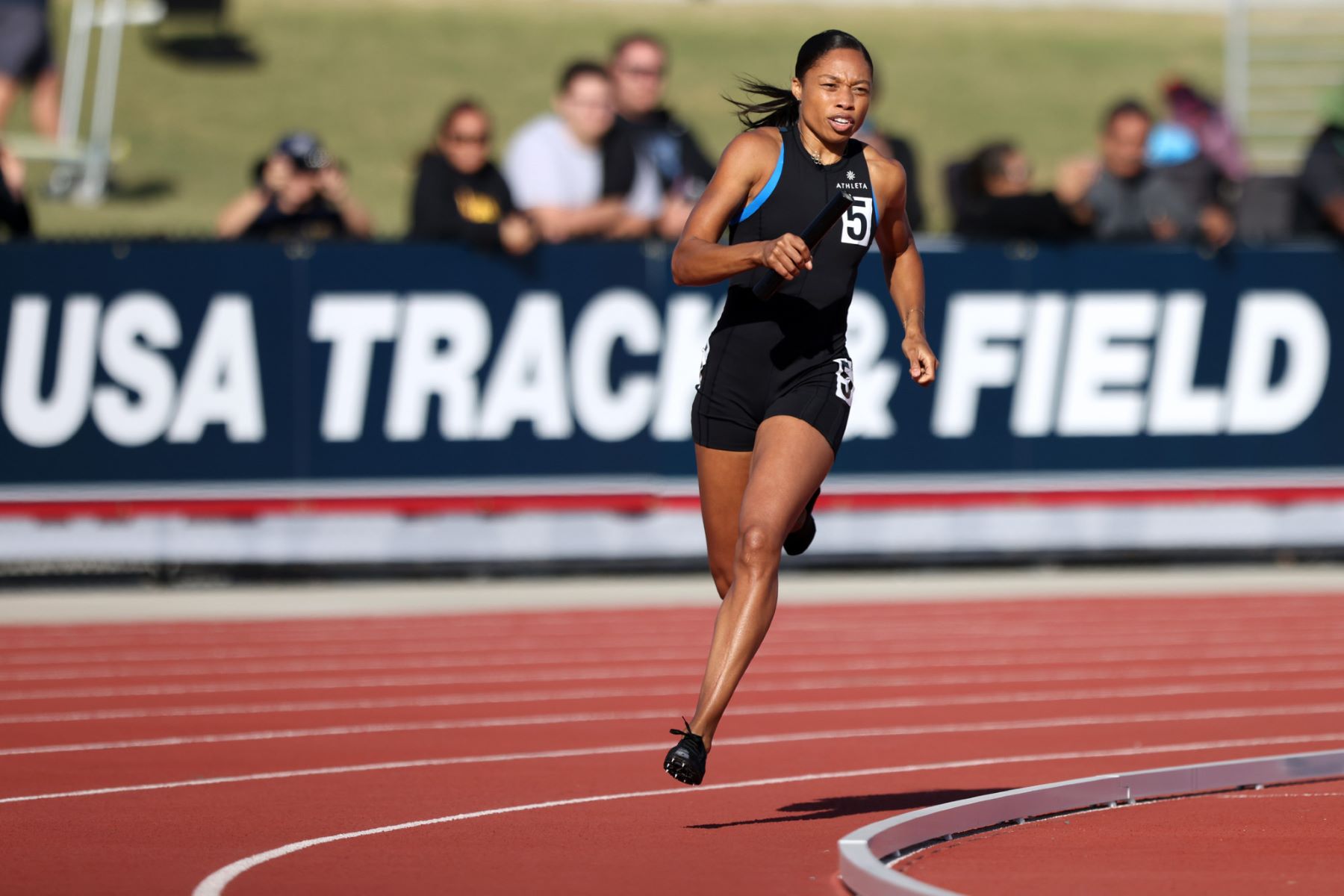

Featured
How Long Is Middle-Distance Running
Modified: March 1, 2024
Discover the ideal length for middle-distance running and how it fits into your training regimen. Featured article on the perfect distance for endurance athletes.
Introduction
Welcome to the exciting world of middle-distance running! Whether you’re a seasoned athlete or just starting out on your running journey, this article will provide you with a comprehensive overview of the sport. From the definition of middle-distance running to training techniques, nutrition considerations, and mental strategies, we’ve got you covered.
But first, let’s start with a brief definition. Middle-distance running refers to races that fall between sprints and long-distance events. Typically, middle-distance races range from 800 meters to 1500 meters, although there is some flexibility depending on the competition level. These races require a unique combination of speed, endurance, and tactical skills.
Now, let’s delve into the historical background of middle-distance running. The origins of this sport can be traced back to ancient Greece, where the Olympic Games first took place. In those times, middle-distance races were an integral part of the athletic events, showcasing the physical prowess and competitive spirit of the athletes.
As the sport evolved over the centuries, training techniques for middle-distance running have also advanced. Athletes now focus on a combination of aerobic and anaerobic exercises, incorporating interval training, speed workouts, and strength training into their routines. Developing a strong cardiovascular system and improving running economy are key goals for middle-distance runners.
However, it’s not just physical training that matters; proper nutrition is also crucial for optimal performance. Middle-distance runners need to fuel their bodies with the right balance of macronutrients, such as carbohydrates, proteins, and fats. Additionally, adequate hydration and timing of meals play vital roles in enhancing endurance and recovery.
Despite the physical and nutritional preparations, middle-distance runners may still encounter injuries along the way. Common injuries in this sport include shin splints, plantar fasciitis, Achilles tendinitis, and stress fractures. It’s important for athletes to be proactive in injury prevention by incorporating rest days, cross-training, and proper warm-ups and cool-downs into their training routines.
Besides the physical challenges, middle-distance running also requires mental fortitude. Athletes must develop mental strategies to stay focused, motivated, and resilient during training and races. Techniques such as visualization, positive self-talk, goal setting, and stress management can make a significant difference in performance and overall well-being.
Definition of Middle-Distance Running
Middle-distance running is a track and field discipline that covers races between sprints and long-distance events. It primarily focuses on races ranging from 800 meters to 1500 meters, although the exact distances may vary depending on the competition level. These races require a unique combination of speed, endurance, and strategic tactics.
In middle-distance running, athletes have to strike a balance between sprinting and maintaining a steady pace over a significant distance. Unlike sprinters who rely heavily on explosive power and long-distance runners who prioritize endurance, middle-distance runners need to excel in both aspects to achieve success.
The 800-meter race, also known as the half-mile, is one of the most challenging and exciting events in middle-distance running. It demands a blend of speed, endurance, and tactical decision-making. Runners must possess the ability to maintain a fast pace from the start while managing their effort to avoid early exhaustion. The race often involves strategic positioning, surges of speed, and a strong kick at the right moment to secure victory.
The 1500-meter race, or the metric mile, is another prominent middle-distance event. This race requires more endurance than the 800-meter race, but speed remains crucial. Runners need to find the optimal balance between maintaining a fast pace and conserving energy to finish strong. Tactics, including positioning, pacing, and timing of the final kick, play a vital role in securing a favorable outcome.
While the 800 meters and 1500 meters are the most common middle-distance races, variations exist, including the 1000 meters and the mile (1609 meters). These races offer unique challenges and require specific training and race strategies.
It’s important to note that middle-distance running is not just confined to track events. It also encompasses races held on road courses, such as the popular 5K and 10K events. These races typically combine elements of middle-distance and long-distance running, requiring athletes to strike a balance between speed and endurance.
Overall, middle-distance running is a thrilling discipline that combines speed, endurance, and strategic thinking. Athletes in this sport must possess a unique skill set and the ability to adapt and respond to varying race scenarios. Whether you’re a competitor, coach, or spectator, middle-distance running offers an exhilarating display of athleticism and tactical prowess.
Historical Background
The origins of middle-distance running can be traced back to ancient Greece, where the Olympic Games first took place. Athletic competitions were an integral part of Greek society, and running played a significant role in these events.
The ancient Greeks admired physical strength and considered running as a symbol of honor and glory. Running races were held in stadiums, and the winners were revered as heroes. Tradition dictated that victors were crowned with laurel wreaths and celebrated as champions.
Middle-distance running, in particular, gained prominence during the ancient Olympic Games. The stadion race, equivalent to about 200 meters, served as the primary sprint event, while the dolichos, ranging from 7 to 24 laps of the stadium, represented the long-distance category.
The middle-distance races filled the gap between these two extremes. The diaulos, a two-stadia race (about 400 meters), and the hoplitodromos, a race where participants ran in full armor, were popular middle-distance events. These races required a balance of speed and endurance, testing the athletes’ physical capabilities.
With the decline of the ancient Greek civilization, interest in running diminished, and it took several centuries for the sport to regain its popularity. The revival of the Olympic Games in the late 19th century sparked a renewed interest in middle-distance running.
By the 20th century, middle-distance races had become a staple in track and field competitions worldwide. The 800 meters and 1500 meters emerged as standard events in international athletics championships, including the Olympics.
Throughout history, legendary middle-distance runners have left their mark on the sport. Names like Sebastian Coe, Steve Ovett, and Hicham El Guerrouj are synonymous with middle-distance greatness. These athletes broke records, won multiple Olympic gold medals, and inspired future generations to pursue excellence in the sport.
Over the years, advances in training methods, sports science, and technology have further enhanced middle-distance running. Athletes now have access to better track surfaces, sophisticated training gear, and advances in nutrition and sports psychology.
Today, middle-distance running continues to captivate audiences with adrenaline-pumping races and jaw-dropping performances. It remains an integral part of track and field events and showcases the extraordinary athletic abilities and determination of the participants.
Training for Middle-Distance Running
Training for middle-distance running requires a combination of aerobic and anaerobic exercises to develop the necessary speed, endurance, and tactical abilities. Athletes must strike a balance between building a strong cardiovascular base and improving their running economy.
Interval training is a key component of middle-distance training. This involves alternating between high-intensity bursts of speed and periods of active recovery. For example, a common interval workout for middle-distance runners is a 4×400-meter repeat, where they sprint for 400 meters and then jog or walk for a short recovery before repeating the cycle. This type of training not only improves speed and power but also enhances the body’s ability to clear lactic acid and recover quickly.
Long runs are also important for middle-distance runners to build endurance. These runs typically range from 8 to 12 kilometers and are performed at a moderate pace. Long runs improve aerobic capacity and help athletes develop mental toughness and the ability to maintain a steady pace over longer distances.
Strength training plays a crucial role in middle-distance running. It helps prevent injuries, improves muscular power, and enhances running economy. Exercises such as squats, lunges, deadlifts, and plyometric drills are commonly included in a middle-distance runner’s strength training program.
Speed workouts are another essential component of middle-distance training. These workouts focus on short, intense efforts to improve running economy and develop top-end speed. Examples include 200-meter or 400-meter repeats performed at near-maximal effort with full recovery between repeats.
Rest and recovery are equally important in middle-distance training. Giving the body time to recover after intense workouts allows for adaptations to take place and helps prevent overuse injuries. Athletes should include regular rest days in their training schedule and prioritize sleep, proper nutrition, and hydration to aid in recovery.
In addition to physical training, middle-distance runners benefit from incorporating mental strategies into their preparation. Visualization techniques, where athletes imagine themselves executing the perfect race, can enhance focus and confidence. Setting specific goals, both short-term and long-term, helps athletes stay motivated and track their progress. Positive self-talk, in which runners use affirmations or mantras to boost their mental resilience, can also be beneficial during training and races.
Ultimately, successful training for middle-distance running requires a well-rounded approach that combines aerobic and anaerobic exercises, strength training, rest, and mental strategies. By following a comprehensive training program tailored to their individual needs, athletes can maximize their potential and achieve their goals in this exhilarating discipline.
Physiological Demands of Middle-Distance Running
Middle-distance running places unique physiological demands on athletes as they strive to excel in both speed and endurance. Understanding the physiological aspects of this sport can help athletes optimize their training and performance.
First and foremost, middle-distance running relies on the efficient functioning of the cardiovascular system. The heart and lungs need to deliver oxygen-rich blood to the working muscles to sustain the required effort. This ability to transport oxygen is known as VO2 max and is a vital determinant of middle-distance running performance. Training programs often target VO2 max through interval training, tempo runs, and long runs, aiming to improve the body’s ability to utilize oxygen during intense efforts.
The anaerobic energy system also plays a significant role in middle-distance running. As the distance increases from sprints, the reliance on anaerobic mechanisms decreases, but it remains crucial for the final kick and surges in speed during races. The development of speed and power through specific anaerobic training, such as short sprints and high-intensity interval training, helps middle-distance runners succeed in these critical moments of the race.
Running economy, or the energy cost of maintaining a given pace, is a key factor in middle-distance running. Efficient running mechanics, including posture, stride length, and cadence, can impact running economy. Middle-distance runners often work on their form and technique during training sessions to optimize their efficiency and conserve energy for longer periods.
The muscular system is also significantly challenged in middle-distance running. The leg muscles, particularly the quadriceps, hamstrings, and calves, must generate substantial power and endurance to sustain a fast pace over the race distance. Strength training exercises, such as squats and lunges, help improve muscular strength and power, leading to improved running performance and injury prevention.
Hydration and electrolyte balance are critical factors in middle-distance running. Dehydration can negatively affect performance and lead to fatigue and cramping. Middle-distance runners should hydrate properly before, during, and after training sessions and races, especially in hot and humid conditions.
Middle-distance running also places stress on the body’s thermoregulatory system. Athletes need to dissipate the heat generated during intense efforts to avoid overheating. Adequate clothing choices, hydration, and training in various environmental conditions can help the body adapt and improve its ability to handle heat stress.
Furthermore, middle-distance runners must consider the nutritional demands of their training and competition. Carbohydrates, fats, and proteins play vital roles in providing the energy and nutrients needed for optimal performance and recovery. A balanced diet that meets the individual athlete’s requirements is crucial for sustaining the physiological demands of the sport.
In summary, middle-distance running places high demands on the cardiovascular system, anaerobic energy pathways, running economy, muscular strength, hydration, thermoregulation, and nutrition. By understanding these physiological demands and tailoring training programs and lifestyle choices accordingly, middle-distance runners can enhance their performance and achieve their goals in this challenging and rewarding sport.
Nutritional Considerations for Middle-Distance Runners
Nutrition plays a crucial role in optimizing performance and recovery for middle-distance runners. Fueling the body with the right balance of macronutrients and micronutrients is essential for sustaining energy levels, enhancing endurance, and promoting overall health. Here are some key nutritional considerations for middle-distance runners.
Carbohydrates are the primary fuel source for middle-distance running. They provide the energy needed for training and racing. Ideally, middle-distance runners should aim to consume complex carbohydrates such as whole grains, fruits, vegetables, and legumes. These sources provide a steady release of energy, preventing energy crashes during long runs or races. It’s also important to choose carbohydrates with a moderate glycemic index to maintain stable blood sugar levels.
Protein plays a crucial role in muscle repair and recovery. Middle-distance runners should aim to consume an adequate amount of protein to promote muscle synthesis and minimize muscle breakdown. Good sources of protein include lean meats, poultry, fish, eggs, dairy products, legumes, and plant-based protein sources such as tofu and tempeh. Timing protein intake around workouts can optimize muscle recovery.
Fats are another important component of a middle-distance runner’s diet. While carbohydrates are the main source of energy during faster-paced efforts, fats provide a long-lasting fuel source during lower intensity runs or throughout the day. Focus on incorporating healthy fats such as avocados, nuts, seeds, olive oil, and fatty fish like salmon into your diet.
Hydration is crucial for middle-distance runners to maintain optimal performance and prevent dehydration. Drinking enough fluids before, during, and after workouts and races is vital. Water is usually sufficient for shorter runs, while longer or more intense efforts may require sports drinks or electrolyte-rich fluids to replenish electrolytes lost through sweat. Monitor hydration levels through urine color and aim for a pale yellow color.
Vitamins and minerals are essential for overall health and optimal performance. Middle-distance runners should aim for a well-balanced diet rich in fruits, vegetables, whole grains, and lean proteins to ensure an adequate intake of vitamins and minerals. It’s also advisable to consult with a healthcare professional or registered dietitian to determine if any specific supplementation is needed based on individual needs.
Eating before and after training or racing is crucial for providing the necessary fuel and aiding in recovery. Pre-workout meals should consist of easily digestible carbohydrates, such as a small bowl of oatmeal or a banana, consumed about 1-2 hours before the run. Post-workout meals should include a combination of carbohydrates and proteins to replenish glycogen stores and promote muscle repair. Chocolate milk, a turkey sandwich, or a protein smoothie are examples of suitable post-workout snacks or meals.
Finally, it’s important for middle-distance runners to listen to their bodies and adjust their nutritional needs accordingly. Everyone is different, and individual tolerances and sensitivities to certain foods may vary. Experimenting with different meal timings, portion sizes, and food choices can help athletes determine what works best for them.
In summary, middle-distance runners should focus on consuming a well-balanced diet that includes carbohydrates, proteins, fats, and essential vitamins and minerals. Adequate hydration before, during, and after workouts or races is crucial. By paying attention to their nutritional needs, middle-distance runners can optimize their performance, enhance recovery, and support overall health and well-being.
Common Injuries in Middle-Distance Running
While middle-distance running can be exhilarating and rewarding, it also poses the risk of injury due to the high physical demands placed on the body. Understanding the common injuries that middle-distance runners may encounter can help athletes prevent and manage these issues effectively.
Shin splints, or medial tibial stress syndrome, are a frequent occurrence in middle-distance runners. They occur due to inflammation of the muscles, tendons, and bone tissue around the shinbone. This condition can result from overuse, improper footwear, or running on hard surfaces. Rest, ice, appropriate footwear, and gradually increasing training intensity can help alleviate symptoms and prevent shin splints.
Another common injury is plantar fasciitis, which involves inflammation of the plantar fascia, a thick band of tissue that runs along the bottom of the foot. Plantar fasciitis can cause heel pain and discomfort, particularly during the first few steps in the morning or after long periods of rest. Adequate rest, gentle stretching exercises, proper arch support, and orthotics can aid in recovery and prevention.
Achilles tendinitis is a condition characterized by inflammation of the Achilles tendon, which connects the calf muscles to the heel bone. It can occur due to overuse, tight calf muscles, or sudden increases in training intensity. Treatment options include rest, stretching, strengthening exercises, and gradual return to running under the guidance of a healthcare professional.
Stress fractures are also common in middle-distance running. These are small cracks in the bones, often occurring in the lower leg or foot. Overtraining, inadequate rest, and poor nutrition can contribute to stress fractures. Diagnosis typically involves imaging studies, and treatment entails rest, immobilization, and a gradual return to running with appropriate support and load management.
IT band syndrome, or iliotibial band syndrome, is a condition that involves inflammation of the iliotibial band, a thick band of connective tissue that runs along the outer side of the thigh. IT band syndrome may cause pain on the outside of the knee or hip during running. Treatment involves rest, stretching, foam rolling, and addressing any underlying biomechanical issues.
In addition to these specific injuries, middle-distance runners are also susceptible to general overuse injuries such as muscle strains, tendonitis, and runner’s knee. It’s crucial for athletes to incorporate proper warm-up and cool-down routines, gradually increase training intensity, and listen to their bodies to avoid pushing too hard and risking injury.
Prevention is key when it comes to injuries in middle-distance running. Incorporating cross-training activities, such as strength training and flexibility exercises, can help improve muscular imbalances and reduce the risk of overuse injuries. Periodizing training and ensuring adequate rest and recovery can also help avoid burnout and reduce the likelihood of injury.
If an injury does occur, early intervention is essential. Seeking professional medical advice, such as consulting a sports medicine physician or physical therapist, can provide proper diagnosis and treatment tailored to the specific injury. It’s important to follow their guidance, adhere to rehabilitation protocols, and gradually return to running to prevent further damage and aid in a successful recovery.
By being proactive in injury prevention, listening to the body, and seeking appropriate care when needed, middle-distance runners can minimize the risk of common injuries and continue to enjoy the sport for years to come.
Mental Strategies for Middle-Distance Runners
Middle-distance running not only requires physical strength and endurance but also mental fortitude. Developing effective mental strategies can help middle-distance runners stay focused, motivated, and resilient during training and races. Here are some key mental strategies that can benefit middle-distance runners.
Visualization is a powerful technique that involves creating vivid mental images of successful races or training sessions. By visualizing themselves executing the perfect race, middle-distance runners can enhance focus, build confidence, and mentally prepare for the challenges they may face. Visualizing specific race scenarios, such as managing surges or executing a strong final kick, can also help athletes feel more prepared and in control during actual competitions.
Positive self-talk is an essential aspect of mental preparation for middle-distance runners. This involves using affirmations, positive statements, or mantras to boost confidence and maintain a positive mindset. By replacing negative thoughts or self-doubt with positive and empowering messages, athletes can overcome mental barriers and stay motivated during challenging moments of training and racing.
Goal setting is another crucial mental strategy for middle-distance runners. Setting specific, measurable, attainable, relevant, and time-bound (SMART) goals helps athletes stay focused, monitor progress, and maintain motivation. It’s important to set both short-term and long-term goals that align with personal aspirations and desired outcomes. Regularly reviewing and adjusting goals as needed ensures continued engagement and a sense of purpose.
Middle-distance races often require strategic decision-making. Developing race strategies and tactical approaches can give athletes a competitive edge. By studying the racecourse, understanding the competition, and knowing their own strengths and weaknesses, middle-distance runners can plan their race tactics and make informed decisions, such as when to make a move, surge, or strategically position themselves in the race.
Middle-distance running can be mentally challenging, especially during tough training sessions or races. Learning effective stress management techniques, such as deep breathing, progressive muscle relaxation, or mindfulness exercises, can help athletes stay calm and focused in high-pressure situations. Practicing relaxation techniques regularly can improve resilience and allow athletes to perform at their best, even in stressful situations.
Mental flexibility is also crucial for middle-distance runners. Being open to adjusting race strategies, adapting to unexpected circumstances, and maintaining a positive outlook despite setbacks or less-than-ideal performances is crucial for long-term success. Middle-distance runners should embrace a growth mindset and view challenges as opportunities for improvement rather than failures.
Finally, finding intrinsic motivation is key for middle-distance runners. Cultivating a deep love and passion for running can fuel the drive to push through difficult times and dedicate oneself to consistent training. Identifying personal reasons for running, such as the enjoyment of competition, the sense of accomplishment, or the pursuit of personal growth, can sustain motivation and enthusiasm throughout the training and racing journey.
In summary, developing effective mental strategies is crucial for middle-distance runners to enhance focus, motivation, and resilience. Visualization, positive self-talk, goal setting, race strategies, stress management, mental flexibility, and finding intrinsic motivation all play vital roles in optimizing mental performance. By incorporating these strategies into their training and racing routines, middle-distance runners can enhance their overall performance and achieve their goals in this challenging and rewarding sport.
Conclusion
Middle-distance running is an exhilarating sport that combines speed, endurance, and tactical thinking. Understanding the various aspects of middle-distance running, from its definition to training techniques, nutritional considerations, common injuries, and mental strategies, is essential for athletes to excel in this discipline.
By focusing on proper training methods, middle-distance runners can enhance their speed, endurance, and running economy. Interval training, long runs, strength training, and rest and recovery all contribute to improving performance and reducing the risk of injury.
Nutrition plays a significant role in fueling the body and maximizing performance in middle-distance running. Consuming a well-balanced diet that includes carbohydrates, proteins, and healthy fats supports energy levels and aids in muscle recovery.
Understanding common injuries in middle-distance running helps athletes take preventive measures and seek appropriate care if needed. Shin splints, plantar fasciitis, Achilles tendinitis, stress fractures, and IT band syndrome are among the injuries that middle-distance runners commonly encounter.
Mental strategies are paramount for success in middle-distance running. Techniques such as visualization, positive self-talk, goal setting, race strategies, stress management, mental flexibility, and finding intrinsic motivation can help athletes stay focused, motivated, and resilient.
In conclusion, middle-distance running is a challenging yet rewarding sport that requires a comprehensive approach encompassing physical and mental preparation. By incorporating these various aspects into their training and racing routines, middle-distance runners can improve their performance, prevent injuries, and reach their full potential in this exciting discipline.









